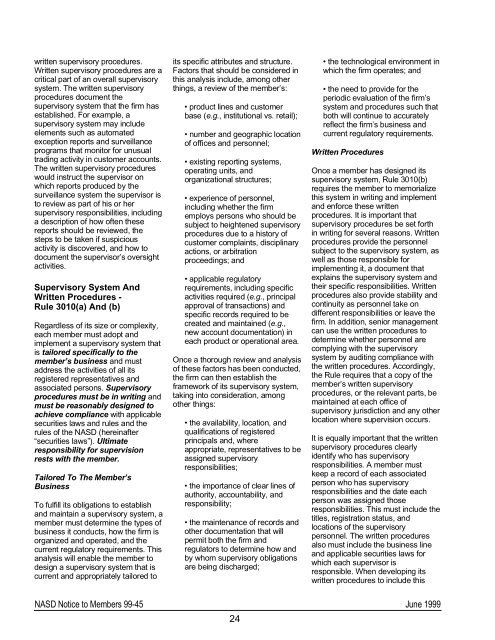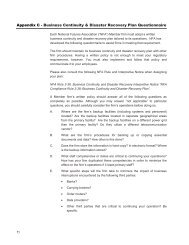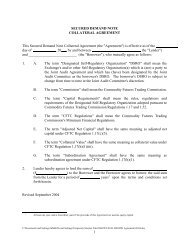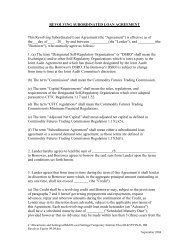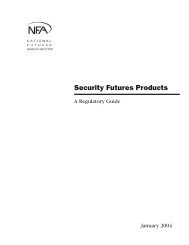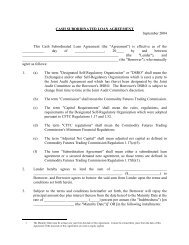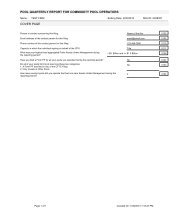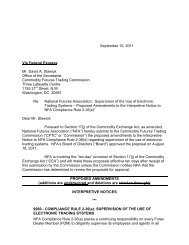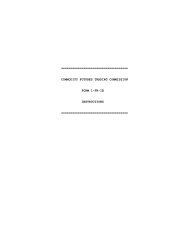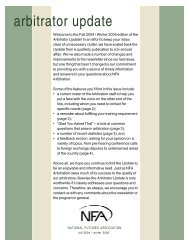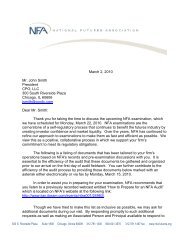NASD Notice to Members 99-45 - National Futures Association
NASD Notice to Members 99-45 - National Futures Association
NASD Notice to Members 99-45 - National Futures Association
Create successful ePaper yourself
Turn your PDF publications into a flip-book with our unique Google optimized e-Paper software.
written supervisory procedures.<br />
Written supervisory procedures are a<br />
critical part of an overall supervisory<br />
system. The written supervisory<br />
procedures document the<br />
supervisory system that the firm has<br />
established. For example, a<br />
supervisory system may include<br />
elements such as au<strong>to</strong>mated<br />
exception reports and surveillance<br />
programs that moni<strong>to</strong>r for unusual<br />
trading activity in cus<strong>to</strong>mer accounts.<br />
The written supervisory procedures<br />
would instruct the supervisor on<br />
which reports produced by the<br />
surveillance system the supervisor is<br />
<strong>to</strong> review as part of his or her<br />
supervisory responsibilities, including<br />
a description of how often these<br />
reports should be reviewed, the<br />
steps <strong>to</strong> be taken if suspicious<br />
activity is discovered, and how <strong>to</strong><br />
document the supervisor’s oversight<br />
a c t i v i t i e s .<br />
Supervisory System And<br />
Written Procedures -<br />
Rule 3010(a) And (b)<br />
Regardless of its size or complexity,<br />
each member must adopt and<br />
implement a supervisory system that<br />
is tailored specifically <strong>to</strong> the<br />
member’s business and must<br />
address the activities of all its<br />
registered representatives and<br />
associated persons. S u p e r v i s o r y<br />
procedures must be in writing a n d<br />
must be reasonably designed <strong>to</strong><br />
achieve compliance with applicable<br />
securities laws and rules and the<br />
rules of the <strong>NASD</strong> (hereinafter<br />
“securities laws”). U l t i m a t e<br />
responsibility for supervision<br />
rests with the member.<br />
Tailored To The Member’s<br />
B u s i n e s s<br />
To fulfill its obligations <strong>to</strong> establish<br />
and maintain a supervisory system, a<br />
member must determine the types of<br />
business it conducts, how the firm is<br />
organized and operated, and the<br />
current regula<strong>to</strong>ry requirements. This<br />
analysis will enable the member <strong>to</strong><br />
design a supervisory system that is<br />
current and appropriately tailored <strong>to</strong><br />
its specific attributes and structure.<br />
Fac<strong>to</strong>rs that should be considered in<br />
this analysis include, among other<br />
things, a review of the member’s:<br />
• product lines and cus<strong>to</strong>mer<br />
base (e . g ., institutional vs. retail);<br />
• number and geographic location<br />
of offices and personnel;<br />
• existing reporting systems,<br />
operating units, and<br />
organizational structures;<br />
• experience of personnel,<br />
including whether the fir m<br />
employs persons who should be<br />
subject <strong>to</strong> heightened supervisory<br />
procedures due <strong>to</strong> a his<strong>to</strong>ry of<br />
cus<strong>to</strong>mer complaints, disciplinary<br />
actions, or arbitration<br />
proceedings; and<br />
• applicable regula<strong>to</strong>ry<br />
requirements, including specific<br />
activities required (e . g ., principal<br />
approval of transactions) and<br />
s p e c i fic records required <strong>to</strong> be<br />
created and maintained (e . g .,<br />
new account documentation) in<br />
each product or operational area.<br />
Once a thorough review and analysis<br />
of these fac<strong>to</strong>rs has been conducted,<br />
the firm can then establish the<br />
framework of its supervisory system,<br />
taking in<strong>to</strong> consideration, among<br />
other things:<br />
• the availability, location, and<br />
q u a l i fications of registered<br />
principals and, where<br />
appropriate, representatives <strong>to</strong> be<br />
assigned supervisory<br />
r e s p o n s i b i l i t i e s ;<br />
• the importance of clear lines of<br />
authority, accountability, and<br />
r e s p o n s i b i l i t y ;<br />
• the maintenance of records and<br />
other documentation that will<br />
permit both the firm and<br />
regula<strong>to</strong>rs <strong>to</strong> determine how and<br />
by whom supervisory obligations<br />
are being discharged;<br />
• the technological environment in<br />
which the firm operates; and<br />
• the need <strong>to</strong> provide for the<br />
periodic evaluation of the fir m ’ s<br />
system and procedures such that<br />
both will continue <strong>to</strong> accurately<br />
r e flect the firm’s business and<br />
current regula<strong>to</strong>ry requirements.<br />
Written Procedures<br />
Once a member has designed its<br />
supervisory system, Rule 3010(b)<br />
requires the member <strong>to</strong> memorialize<br />
this system in writing and implement<br />
and enforce these written<br />
procedures. It is important that<br />
supervisory procedures be set forth<br />
in writing for several reasons. Written<br />
procedures provide the personnel<br />
subject <strong>to</strong> the supervisory system, as<br />
well as those responsible for<br />
implementing it, a document that<br />
explains the supervisory system and<br />
their specific responsibilities. Written<br />
procedures also provide stability and<br />
continuity as personnel take on<br />
different responsibilities or leave the<br />
firm. In addition, senior management<br />
can use the written procedures <strong>to</strong><br />
determine whether personnel are<br />
complying with the supervisory<br />
system by auditing compliance with<br />
the written procedures. Accordingly,<br />
the Rule requires that a copy of the<br />
member’s written supervisory<br />
procedures, or the relevant parts, be<br />
maintained at each office of<br />
supervisory jurisdiction and any other<br />
location where supervision occurs.<br />
It is equally important that the written<br />
supervisory procedures clearly<br />
identify who has supervisory<br />
responsibilities. A member must<br />
keep a record of each associated<br />
person who has supervisory<br />
responsibilities and the date each<br />
person was assigned those<br />
responsibilities. This must include the<br />
titles, registration status, and<br />
locations of the supervisory<br />
personnel. The written procedures<br />
also must include the business line<br />
and applicable securities laws for<br />
which each supervisor is<br />
responsible. When developing its<br />
written procedures <strong>to</strong> include this<br />
<strong>NASD</strong> <strong>Notice</strong> <strong>to</strong> <strong>Members</strong> <strong>99</strong>-<strong>45</strong> June 1<strong>99</strong>9<br />
24


